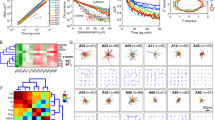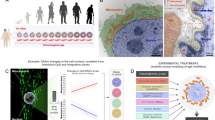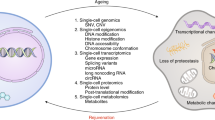Abstract
Ageing research has focused either on assessing organ- and tissue-based changes, such as lung capacity and cardiac function, or on changes at the molecular scale such as gene expression, epigenetic modifications and metabolism. Here, by using a cohort of 32 samples of primary dermal fibroblasts collected from individuals between 2 and 96 years of age, we show that the degradation of functional cellular biophysical features—including cell mechanics, traction strength, morphology and migratory potential—and associated descriptors of cellular heterogeneity predict cellular age with higher accuracy than conventional biomolecular markers. We also demonstrate the use of high-throughput single-cell technologies, together with a deterministic model based on cellular features, to compute the cellular age of apparently healthy males and females, and to explore these relationships in cells from individuals with Werner syndrome and Hutchinson–Gilford progeria syndrome, two rare genetic conditions that result in phenotypes that show aspects of premature ageing. Our findings suggest that the quantification of cellular age may be used to stratify individuals on the basis of cellular phenotypes and serve as a biological proxy of healthspan.
This is a preview of subscription content, access via your institution
Access options
Access Nature and 54 other Nature Portfolio journals
Get Nature+, our best-value online-access subscription
$29.99 / 30 days
cancel any time
Subscribe to this journal
Receive 12 digital issues and online access to articles
$119.00 per year
only $9.92 per issue
Buy this article
- Purchase on SpringerLink
- Instant access to full article PDF
Prices may be subject to local taxes which are calculated during checkout





Similar content being viewed by others
References
Lopez-Otin, C., Blasco, M. A., Partridge, L., Serrano, M. & Kroemer, G. The hallmarks of aging. Cell 153, 1194–1217 (2013).
Belsky, D. W. et al. Quantification of biological aging in young adults. Proc. Natl Acad. Sci. USA 112, E4104–E4110 (2015).
Smith, B. D., Smith, G. L., Hurria, A., Hortobagyi, G. N. & Buchholz, T. A. Future of cancer incidence in the United States: burdens upon an aging, changing nation. J. Clin. Oncol. 27, 2758–2765 (2009).
Kennedy, B. K. et al. Geroscience: linking aging to chronic disease. Cell 159, 708–712, (2014).
Bocklandt, S. et al. Epigenetic predictor of age. PLoS ONE 6, e14821 (2011).
Horvath, S. DNA methylation age of human tissues and cell types. Genome Biol. 14, R115 (2013).
Wirtz, D., Konstantopoulos, K. & Searson, P. C. The physics of cancer: the role of physical interactions and mechanical forces in metastasis. Nat. Rev. Cancer 11, 512–522 (2011).
Phillip, J. M., Aifuwa, I., Walston, J. & Wirtz, D. The mechanobiology of aging. Annu. Rev. Biomed. Eng. 17, 113–141 (2015).
Rodier, F. & Campisi, J. Four faces of cellular senescence. J. Cell Biol. 192, 547–556 (2011).
Baker, D. J. et al. Clearance of p16Ink4a-positive senescent cells delays ageing-associated disorders. Nature 479, 232–236 (2011).
Wirtz, D. Particle-tracking microrheology of living cells: principles and applications. Annu. Rev. Biophys. 38, 301–326 (2009).
Ingber, D. E. Mechanobiology and diseases of mechanotransduction. Ann. Med. 35, 564–577 (2003).
Makale, M. Cellular mechanobiology and cancer metastasis. Birth Defects Res. C Embryo Today 81, 329–343 (2007).
Altschuler, S. J. & Wu, L. F. Cellular heterogeneity: do differences make a difference? Cell 141, 559–563 (2010).
Darling, E. M. & Di Carlo, D. High-throughput assessment of cellular mechanical properties. Annu. Rev. Biomed. Eng. 17, 35–62 (2015).
Starodubtseva, M. N. Mechanical properties of cells and ageing. Ageing Res. Rev. 10, 16–25 (2011).
Martin, P. Wound healing—aiming for perfect skin regeneration. Science 276, 75–81 (1997).
Fraley, S. I. et al. A distinctive role for focal adhesion proteins in three-dimensional cell motility. Nat. Cell Biol. 12, 598–604 (2010).
Wu, P. H., Giri, A. & Wirtz, D. Statistical analysis of cell migration in 3D using the anisotropic persistent random walk model. Nat. Protoc. 10, 517–527 (2015).
Wu, P. H., Giri, A., Sun, S. X. & Wirtz, D. Three-dimensional cell migration does not follow a random walk. Proc. Natl Acad. Sci. USA 111, 3949–3954 (2014).
Munevar, S., Wang, Y. & Dembo, M. Traction force microscopy of migrating normal and H-ras transformed 3T3 fibroblasts. Biophys. J. 80, 1744–1757 (2001).
Aifuwa, I. et al. Senescent stromal cells induce cancer cell migration via inhibition of RhoA/ROCK/myosin-based cell contractility. Oncotarget 6, 30516–30531 (2015).
Aratyn-Schaus, Y., Oakes, P. W., Stricker, J., Winter, S. P. & Gardel, M. L. Preparation of complaint matrices for quantifying cellular contraction. J. Vis. Exp. e2173 (2010).
Stroka, K. M. et al. Loss of giant obscurins alters breast epithelial cell mechanosensing of matrix stiffness. Oncotarget http://dx.doi.org/10.18632/oncotarget.10997 (2016).
Kim, D. H. & Wirtz, D. Cytoskeletal tension induces the polarized architecture of the nucleus. Biomaterials 48, 161–172 (2015).
Hale, C. M. et al. SMRT analysis of MTOC and nuclear positioning reveals the role of EB1 and LIC1 in single-cell polarization. J. Cell Sci. 124, 4267–4285 (2011).
Wu, P. H. et al. High-throughput ballistic injection nanorheology to measure cell mechanics. Nat. Protoc. 7, 155–170 (2012).
Lee, J. S. et al. Nuclear lamin A/C deficiency induces defects in cell mechanics, polarization, and migration. Biophys. J. 93, 2542–2552 (2007).
Lee, J. S. et al. Ballistic intracellular nanorheology reveals ROCK-hard cytoplasmic stiffening response to fluid flow. J. Cell Sci. 119, 1760–1768 (2006).
Tseng, Y. et al. How actin crosslinking and bundling proteins cooperate to generate an enhanced cell mechanical response. Biochem. Biophys. Res. Commun. 334, 183–192 (2005).
Chen, W. C. et al. Functional interplay between the cell cycle and cell phenotypes. Integr. Biol. (Camb.) 5, 523–534 (2013).
Wu, P. H. et al. Evolution of cellular morpho-phenotypes in cancer metastasis. Sci. Rep. 5, 18437 (2015).
Guo, Q. Y. et al. Modulation of keratocyte phenotype by collagen fibril nanoarchitecture in membranes for corneal repair. Biomaterials 34, 9365–9372 (2013).
Shah, M. Y. et al. MMSET/WHSC1 enhances DNA damage repair leading to an increase in resistance to chemotherapeutic agents. Oncogene 35, 5905–5915 (2016).
Yong, K. M. A. et al. Morphological effects on expression of growth differentiation factor 15 (GDF15), a marker of metastasis. J. Cell Physiol. 229, 362–373 (2014).
Hecht, V. C. et al. Biophysical changes reduce energetic demand in growth factor-deprived lymphocytes. J. Cell Biol. 212, 439–447 (2016).
Hayflick, L. Recent advances in the cell biology of aging. Mech. Ageing Dev. 14, 59–79 (1980).
Bratic, A. & Larsson, N. G. The role of mitochondria in aging. J. Clin. Invest. 123, 951–957 (2013).
Green, D. R., Galluzzi, L. & Kroemer, G. Mitochondria and the autophagy-inflammation-cell death axis in organismal aging. Science 333, 1109–1112 (2011).
Miyoshi, N., Oubrahim, H., Chock, P. B. & Stadtman, E. R. Age-dependent cell death and the role of ATP in hydrogen peroxide-induced apoptosis and necrosis. Proc. Natl Acad. Sci. USA 103, 1727–1731 (2006).
Smart, N. et al. IL-6 induces PI 3-kinase and nitric oxide-dependent protection and preserves mitochondrial function in cardiomyocytes. Cardiovasc. Res. 69, 164–177 (2006).
Lu, Y. et al. High-throughput secretomic analysis of single cells to assess functional cellular heterogeneity. Anal. Chem. 85, 2548–2556 (2013).
Waldera Lupa, D. M. et al. Characterization of skin aging-associated secreted proteins (SAASP) produced by dermal fibroblasts isolated from intrinsically aged human skin. J. Invest. Dermatol. 135, 1954–1968 (2015).
Chambliss, A. B., Wu, P. H., Chen, W. C., Sun, S. X. & Wirtz, D. Simultaneously defining cell phenotypes, cell cycle, and chromatin modifications at single-cell resolution. FASEB J. 27, 2667–2676 (2013).
Wu, P. H. et al. Evolution of cellular morpho-phenotypes in cancer metastasis. Sci. Rep. 5, 18437 (2015).
Sedelnikova, O. A. et al. Delayed kinetics of DNA double-strand break processing in normal and pathological aging. Aging Cell 7, 89–100 (2008).
Kreiling, J. A. et al. Age-associated increase in heterochromatic marks in murine and primate tissues. Aging Cell 10, 292–304 (2011).
Isermann, P. & Lammerding, J. Nuclear mechanics and mechanotransduction in health and disease. Curr. Biol. 23, R1113–R1121 (2013).
Kim, D. H., Chambliss, A. B. & Wirtz, D. The multi-faceted role of the actin cap in cellular mechanosensation and mechanotransduction. Soft Matter 9, 5516–5523 (2013).
Khatau, S. B. et al. A perinuclear actin cap regulates nuclear shape. Proc. Natl Acad. Sci. USA 106, 19017–19022 (2009).
Schulze, C. et al. Stiffening of human skin fibroblasts with age. Clin. Plast. Surg. 39, 9–20 (2012).
Niepel, M., Spencer, S. L. & Sorger, P. K. Non-genetic cell-to-cell variability and the consequences for pharmacology. Curr. Opin. Chem. Biol. 13, 556–561 (2009).
Bahar, R. et al. Increased cell-to-cell variation in gene expression in ageing mouse heart. Nature 441, 1011–1014 (2006).
Burch, J. B. et al. Advances in geroscience: impact on healthspan and chronic disease. J. Gerontol. A Biol. Sci. Med. Sci. 69, S1–S3 (2014).
Espinoza, S. & Walston, J. D. Frailty in older adults: insights and interventions. Cleve. Clin. J. Med. 72, 1105–1112 (2005).
Blagosklonny, M. V. Why men age faster but reproduce longer than women: mTOR and evolutionary perspectives. Aging 2, 265–273 (2010).
Ortman, J. M., Velkoff, V. A. & Hogan, H. An Aging Nation: The Older Population in the United States Current Population Report P25–1140 (US Census Bureau, 2014).
Waldron, I. Why do women live longer than men? Soc. Sci. Med. 10, 349–362 (1979).
Waldron, I. What do we know about causes of sex differences in mortality? A review of the literature. Popul. Bull. UN 18, 59–76 (1985).
Nakamura, E. & Miyao, K. Sex differences in human biological aging. J. Gerontol. A Biol. Sci. Med. Sci. 63, 936–944 (2008).
Voitenko, V. P. & Tokar, A. V. The assessment of biological age and sex differences of human aging. Exp. Aging Res. 9, 239–244 (1983).
Childs, B. G., Durik, M., Baker, D. J. & van Deursen, J. M. Cellular senescence in aging and age-related disease: from mechanisms to therapy. Nat. Med. 21, 1424–1435 (2015).
van Deursen, J. M. The role of senescent cells in ageing. Nature 509, 439–446 (2014).
Campisi, J. Aging, cellular senescence, and cancer. Annu. Rev. Physiol. 75, 685–705 (2013).
Campisi, J. Cellular senescence, cancer and aging. Mol. Biol. Cell. 15, 354a (2004).
Campisi, J. Cancer, aging and cellular senescence. In Vivo 14, 183–188 (2000).
Campisi, J., Andersen, J. K., Kapahi, P. & Melov, S. Cellular senescence: a link between cancer and age-related degenerative disease? Semin. Cancer Biol. 21, 354–359 (2011).
Campisi, J. & di Fagagna, F. D. Cellular senescence: when bad things happen to good cells. Nat. Rev. Mol. Cell Bio. 8, 729–740 (2007).
Campisi, J., Kim, S. H., Lim, C. S. & Rubio, M. Cellular senescence, cancer and aging: the telomere connection. Exp. Gerontol. 36, 1619–1637 (2001).
Coppe, J. P., Desprez, P. Y., Krtolica, A. & Campisi, J. The senescence-associated secretory phenotype: the dark side of tumor suppression. Annu. Rev. Pathol. Mech. 5, 99–118 (2010).
Kafri, R. et al. Dynamics extracted from fixed cells reveal feedback linking cell growth to cell cycle. Nature 494, 480–483 (2013).
Acknowledgements
We acknowledge the financial support for this work by the National Institutes of Health; grant numbers U54CA143868 (D.W.), R01CA174388 (D.W.) and P30AG021334 Johns Hopkins Older Americans Independence Center (J.W.). Special thanks to M. Maggioni, and Q-L. Xue for feedback and discussion with regards to the statistical methodologies employed in this study.
Author information
Authors and Affiliations
Contributions
J.M.P., D.W., J.W. and J.S.H.L. conceived and designed the study. J.M.P., W.W., S.M., J.D. and I.A. performed the experiments. J.M.P., P.-H.W. and D.W. analysed the results. P.-H.W. and J.M.P. developed the analysis software and algorithms. J.C. and R.F. generated and analysed the secretion microchip data. D.W., P.-H.W., D.M.G. and J.W. supervised the study. J.M.P., D.W. and J.W. wrote and edited the manuscript.
Corresponding author
Ethics declarations
Competing interests
The authors declare no competing financial interests.
Supplementary information
Supplementary Information
Supplementary figures, tables and references. (PDF 1443 kb)
Supplementary dataset
Replicative history of the cells, and parameter list and correlations. (XLSX 2520 kb)
Rights and permissions
About this article
Cite this article
Phillip, J., Wu, PH., Gilkes, D. et al. Biophysical and biomolecular determination of cellular age in humans. Nat Biomed Eng 1, 0093 (2017). https://doi.org/10.1038/s41551-017-0093
Received:
Accepted:
Published:
DOI: https://doi.org/10.1038/s41551-017-0093
This article is cited by
-
High-throughput mechanical phenotyping and transcriptomics of single cells
Nature Communications (2024)
-
Distinguishing cells using electro-acoustic spinning
Scientific Reports (2023)
-
Measuring and modelling tumour heterogeneity across scales
Nature Reviews Bioengineering (2023)
-
Morphological profiling by high-throughput single-cell biophysical fractometry
Communications Biology (2023)
-
Machine learning-based morphological quantification of replicative senescence in human fibroblasts
GeroScience (2023)



